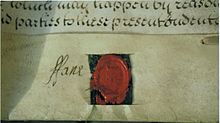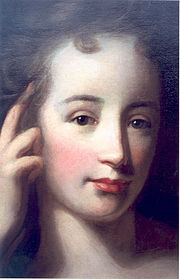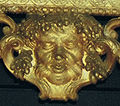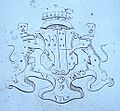- Charles Fane, 1st Viscount Fane
-
Charles Fane, 1st Viscount Fane PC (Ire) (January 1676 – 4 July 1744) was an English courtier, politician and a landowner in both England and Ireland.}
 Fane's signature on his daughter Mary's Marriage Settlement, 1734
Fane's signature on his daughter Mary's Marriage Settlement, 1734
Fane or ffane was baptised at Basildon in Berkshire on 30 January 1676, he was the second son but heir of the Right Hon. Sir Henry Fane, of Basildon, KB, (1650-1705/06), by his wife Elizabeth, daughter of Thomas Southcott of Exeter.[citation needed]
His elder brother's death made him eventual heir to the Bourchier estates; the manors of Lough Gur and Glenogra in county Limerick and of Clare, near Tandragee, in county Armagh; to the Fane estate at Basildon in Berkshire; and to the Southcott estate at Calwoodley in Devon.[citation needed]
The elder brother Henry Bourchier Fane was Standard Bearer of the Gentlemen Pensioners from 10 April 1689 until early 1696 when he was killed in a duel by one Elias Burgess. This no doubt the same Colonel Elizeus Burges, a self confessed drinker and womaniser, who was commissioned (17 March), and proclaimed (9 November), Governor of (the province of) Massachusetts (Bay) but never took up the office and resigned April 1716.[citation needed] He was, however, British Resident in Venice from 1719–1722, and 1727 to his death in 1736. On 9 November 1715 Elizeus Burgess was proclaimed Governor, he having been commissioned on 17 March 1715, but he nevercame over to perform his duties, and resigned the office in April 1716.[citation needed]
Having left Wadham College, Oxford (he had matriculated 3 April 1693, fil. eq. de Balneo natu minor. Taken up for Battels, 21 January 1702/03.)) Fane duely replaced his unfortunate elder brother as Standard Bearer from 20 April 1696, a post he had vacated by 31 March 1712.[citation needed]
Meanwhile his younger brother George Fane had become Commander of the Royal ship the Lowestoffe, (a 5th rate, 104.5 x 28-foot (8.5 m) ship built at Chatham dockyard in 1697). Appointed Captain in 1709, he died without issue at New York the same year.
Fane was appointed Deputy Lieutenant (DL) for Berkshire, 21 September 1715. He was Member of the Irish Parliament (MP) for Killybegs in county Donegal, a seat controlled by the Conygham family, from 1715 to 1719.[citation needed]
On 22 April 1718 he was created Baron of Loughguyre, in the county of Limerick, and Viscount Fane, both in the Peerage of Ireland, and number 264 on the roll. He took his seat 21 April 1725, having been appointed to the Irish Privy Council on 5 May 1718.[citation needed]
He stood unsuccessfully for Berkshire in the election of 30 August 1727. At the poll Fane (1319 votes) was beaten into third place by Robert Packer (1620 votes), a distant ancestor of the late Kerry Packer, and by Sir John Stonhouse (1558 votes).[citation needed]
Contents
His wife
 Lady Fane, detail of a portrait by Schalken, 1702.
Lady Fane, detail of a portrait by Schalken, 1702.
Fane married at the Chelsea Hospital, 12 December 1707 (license dated 19 November 1707), Mary (1686–1762) daughter of the envoy hon. Alexander Stanhope, FRS, (the youngest son of the first Earl of Chesterfield), by Catherine (d.1718), daughter and co-heir of Arnold Burghill, of Thingehill Parva, Withington, Herefordshire by his second wife Grizell, co-heir of John Prise of Ocle Pyrchard, Herefordshire. A sister of soldier-statesman James, Earl Stanhope (1673–1721), Mary Fane was also an old friend of the Mistress of the Robes, Sarah Churchill, Duchess of Marlborough having been one of the six original Maids of Honour to Queen Anne, appointed 4 June 1702, an office she had vacated by November 1707.[citation needed]
An indenture of settlement dated 19 November 1707 between Charles Fane of Basildon and others, had her marriage portion at 3,000 L (pounds). Robert Walpole, the husband of Mary's first cousin twice-removed Catherine Shorter (c.1682-1737) aka cousin Walpole, was a witness.[citation needed]
Fane died 7 July 1744 and was buried at Basildon 16 July 1744, aged 68. His widow died 21 and was buried at Basildon on the 30 August 1762, aged 76. They had seven children.[citation needed]
- Charles, 2nd Viscount Fane;
- Mary who married Jerome, 2nd Count de Salis;
- Elizabeth of Windsor (1711–1760);
- Dorothy Fane who married John Montagu, 4th Earl of Sandwich;
- Charlotte of Chelsea (1718–1765), (& c1751, of 10, Old Burlington Street);
- and two who died as children, Lucy (d.1713) and James (d.1714).
Grotto
In the 1720s and 30s she built the sometime renowned Grotto at the Fane's New House by the Thames at Lower Basildon, but in the parish of Streatley in Berkshire. These extracts show some of the process:
- Lady Fane in London, writing to her husband at Basildon, on April ye 1st / 1731:
-
- ...I desire to have
- notice of the first barge that comes to town
- I hope you received the things I sent last week
- 3 pairs of andirons 6 pairs of blankets three hampers
- of empty bottles some stones and shells which
- were directed to be left att the new house and
- the painted cloaths which are to cost a vast
- sum of mony.
—Lady Fane.[citation needed]- And to her husband, this time from Florence, November 1736:
-
- ..when I go home I shall finish my Grotto as fast as possible
- and then I shall want to make a door in that little place.
—Lord Fane.[citation needed]Her son, Charles, was appointed British Resident (Horace Walpole's friend Sir Horace Mann was his assistant then successor as Resident) in Florence in March 1734 and was there in person between 3 October 1734 and the Spring of 1738. Lady Fane and her daughter Dorothy were there with him from June 1736. Dorothy stayed until at least June 1737, this extract from a letter to Lady Fane suggests that the mother too was there for a year:
- Sarah, Duchess of Marlborough, from Wimbledon, to Lady Fane, 23rd September 1737:
-
- ... I am glad to find that you have had the pleasure of passing
- a whole year with your son
—Sarah, Duchess of Marlborough.[citation needed]It is probable that during this trip Lady Fane ordered her pair of prized scagliola table tops from the Irishman Friar Ferdinando Henrico Hugford (1695–1771). These are quite similar to the one at The Vyne, Hampshire. That top has the arms of Walpole (with his post-1726 Garter Knight embellishments) impaling Shorter - for Prime Minister Sir Robert Walpole and his first wife Catherine Shorter, who died 20 August 1737. The hint of shells on the tables suggest that they may have been for her grotto at the New House, Basildon.[citation needed]
In 1747 the blue-stocking and fellow Berkshire-dweller Elizabeth Montagu (1720–1800) described the Fane grotto:
- the situation is like most grottoes, placed where a grotto would not be looked for:
- it joins to the house. Now having told its only defect, I will go on to the rest.
- The first room is fitted up entirely with shells, the sides and ceilings in beautiful mosaic,
- a rich cornice of flowers in baskets and cornucopias, and little yellow sea
- snail is so disposed in shades as to resemble knots of ribbon which seem
- to tye up some of the bunches of flowers.
- There is a bed for the Hermit, which is composed of rich shells and so
- shaded that the curtain seems folded and flowing...
- the room adjoining it is rough work in a very bold taste,
- the water falls down into a cold bath.
- The grotto is about 50 yards from the Thames, to which the descent is very precipitate.
- From the shell room you have a view of it.
- The House to which this grotto is joined is a small habitation where
- Lady Fane used to spend a good deal of time. Lord Fane's seat is about a mile from it.
Gallery
-
Mary ffane to her husband, reporting the birth of the future Philip, 2nd Earl Stanhope in August 1714.
-
Letter from Sarah, Duchess of Marlborough to Lady ffane, 1737
-
Florentine scagliola table top with arms of Fane impalling Stanhope, c1737
-
Detail of Bacchus on one of a pair of side-tables made for Lord Fane and/or his wife c1740 (part of the base for the scagliola)
-
Britannia gauge silver waiter dated 1732, with Fane crests and arms of Fane impaling Stanhope. Maker, Paul de Lamerie.
-
Coat of arms on a silver waiter dated 1732, showing arms of Fane impaling Stanhope, for Charles Fane and his wife Mary, possibly a 25th wedding present.
Notes
- ^ Climenson 1906, p. 245
References
- de Salis, R. (2003). Quadrennial di Fano Saliceorum. one. London: [publisher needed].
- Cokayne, G. E.; Gibbs, Vicary; Doubleday, H.A. (1926). The Complete Peerage.... 5. London: St. Catherine Press.
- Pheasant, Pam (2003). The Grotto House, Toil and Leisure in a modest country house in Berkshire. ILAM. ISBN 1-873903-99-5.
- other printed ('V.C.H.), and manuscript & family knowledge.
- The House of Commons 1715-1754. H.M.S.O. for H.P.T.. 1970.
- Johnston-Liik, Edith Mary (2002). History of the Irish Parliament 1692 - 1800, Commons, Constituencies and statutes. 4. Ulster Historical Foundation.
- John Farrington's print of Basselden from Streatley Hill, 1793
- Gardiner, Rev. Robert Barlow; Bell, George (1889). The Registers of Wadham College, Oxford, part 1, 1613-1719. Covent Garden: [publisher needed].
- Climenson, Emily J, ed (1906). Elizabeth Montagu the Queen of the blue stockings: her correspondence from 1720 to 1761. 1. London: [publisher needed].
- de Salis, R. (2008). Fane-Stanhope scagliola. London: [publisher needed].
Parliament of Ireland Preceded by
Thomas Pearson
Henry MaxwellMember of Parliament for Killybegs
1715–1719
With: Thomas PearsonSucceeded by
Thomas Pearson
Robert ColvillPeerage of Ireland New creation Viscount Fane
1718–1744Succeeded by
Charles FaneBaron of Loughguyre
1718–1744Categories:- 1676 births
- 1744 deaths
- Alumni of Wadham College, Oxford
- Irish MPs 1715–1727
- People from Basildon, Berkshire
- People from County Armagh
- People from Devon
- Members of the Parliament of Ireland (pre-1801)
- Members of the Privy Council of Ireland
- Viscounts in the Peerage of Ireland
- Fane family
Wikimedia Foundation. 2010.











